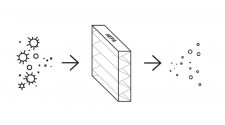Researchers have invented a desalination device that can turn seawater into drinking water at the push of a button. The technology uses a technique that essentially zaps the water with electricity in order to remove salt molecules, bacteria and viruses. This eliminates the need for replacement filters and high-pressure pumps, which current commercially available desalination units require.
Packaged in a suitcase-sized device, it weighs less than 20 lbs. and can be powered with a portable solar panel.
This makes it suitable for use in remote and severely resource-limited areas, according to the team at Massachusetts Institute of Technology (MIT) who developed it.

The water generated by the desalination unit exceeds World Health Organisation quality standards thanks to a two-stage process that removes both dissolved and suspended solids.
It is designed to be used by nonexperts, and can be controlled wirelessly through a companion smartphone app.
A prototype was successfully tested, generating 0.3 litres of drinking water per hour straight from the sea.
Professor Nidal Hilal, director of the New York University Abu Dhabi Water research centre, said the setup requires expensive materials.
“It would be interesting to see similar systems with low-cost materials in place,” he said.











